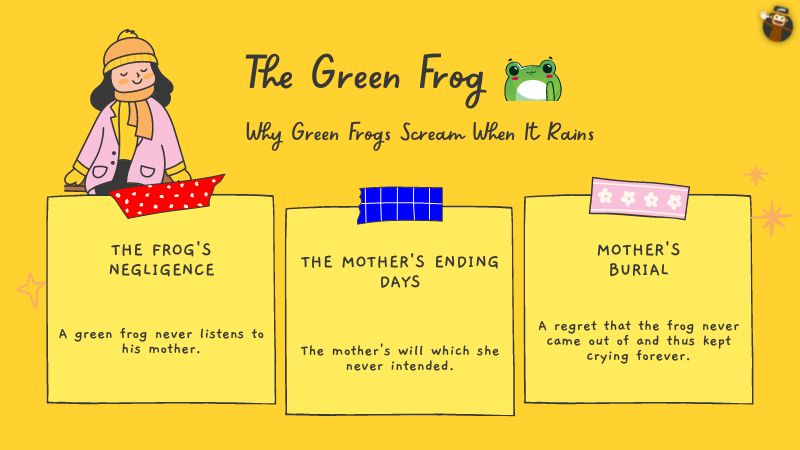Korean folklore dates back more than 1000 years, and it combines indigenous stories with elements from Buddhism, Taoism, Confucianism, Korean Shamanism, and other religions. If you want to be enlightened by some amazing Korean stories to tell your kids, then keep reading, as we have a lot in store for you today. Let’s get started!
Korean Folk Tales
Korean folk tales are enriched with colorful customs and aspects of other Asian countries. In the first seven years of every Korean child, these folk tales are told to the child so they start learning about how adults should behave as they grow old. It is also viewed as a creative tool to enhance the kids’ imagination and teach them critical aspects related to the country’s beliefs, history, and rituals.
Four Major Virtues Of Korean Folk Tales
There are four significant virtues of Korean literature. As the Korean folk tales come under the umbrella of Korean literature, thus they also manifest these virtues.
Filial Piety
If you belong to a society built on Confucious values, then you must already be aware of filial piety. However, if you are a freshie, let me enlighten you.
Filial piety explains the idea of having feelings of devotion, love, and obedience towards your ancestors. In the Confuscious philosophy, respect towards elders is a crucial aspect which is also shown in their language as Korean have different honorific terms for their elders.
Even while reading most of the Korean folk tales, you will realize that the majority end with a guiding lesson for the kids to respect their elders, especially their parents. Also, most folk tales have the role of parents or an elderly figure, even if the moral lesson is about something else, to show the importance of their existence.
Wisdom
Another thing that makes Korean folk tales stand out is the wisdom of generations inside one story. Each story serves as a guide on how to live a better life by making proper decisions, and it also outlines how making stupid decisions could lead to regret. Whatever the ancestors have gained through the ages of experience is then compiled in one story to help the next generations learn from the stories instead of making the same mistakes.
Good Deeds
A majority of Korean folk tales highlight the importance of good deeds, like helping others, not being greedy, etc. You will find this in almost every other Korean folk tale. The kids are taught to be kind and courageous by always standing up for the weak and what’s right. Technically, the concept here is simple: do good and be rewarded!
Honesty
And finally, honesty. Honesty is a virtue that is non-negotiable and uncompromised in Korean literature. Koreans want to instill ethical values in their children, with honesty being the major. Korean literature mainly includes stories in which people are told to be honest to achieve significance and happiness. The characters shown as genuine in Korean folk tales always have happy endings, and this is not necessarily true in real life, but it surely helps bring up the kids in a righteous way.
Four major Folk Tales That You Must Know About
This article will tell you about four must-know Korean folktales to broaden your child’s horizons.
The Green Frog

The green frog is a famous Korean folktale that comes above all the others while reading Korean folk tales to a kid before sleeping as this gives kids suitable lessons, i.e., to listen to their parents. The primary virtue of this folk tale is filial piety.
The Frog’s Negligence
The green frog once shared a little pond with his mother, who was widowed. When his mother instructed him to do something, the green frog often ignored her. His response to everything was like “Ei,” a neglectful Korean exclamation. The mother frog was concerned about what she would do with her kid because he upset her and made her feel ashamed. She was aware that she would need to take action to change his undesirable behaviors.
The Mother’s Ending Days
As the mother frog grew older, she panicked so much that she ultimately fell ill. Even yet, the green frog has not changed his behavior. The mother frog eventually called her kid to bed when she realized she was about to die. She knew the green frog would do the contrary of what she told him, so she said, “Do not put me on the hillside when I pass away. On the riverbank, you must grave me”. The frog’s mother pleaded, “Promise me. “You have to swear.” The green frog vowed to keep his word.
Mother’s Burial
The mother frog passed away, and the young frog was heartbroken. He took responsibility for her passing and expressed regret for the pain he had given her. He thought, “I always did the contrary of what she advised me when she was here, so now I’m going to do as she instructed me.” The green frog decided to bury his mother beside the river, realizing it was a bad idea. And as it poured, he kept vigil while pleading with God to keep the water level from rising. But that season’s playoffs, rain storms caused the river to increase steadily, spilling over its borders and removing his mother’s grave site.
Why Green Frogs Scream When It Rains
The green frog sobbed unstoppably for his mother as he sat in the pouring rain on the riverbank. And for this reason, green frogs still scream when it rains, according to the myths in Korean culture. This folk tale highlights the virtue of wisdom in it.
The Rabbit’s Liver

The rabbit’s liver is a great story for kids to know that the empowered tend to take advantage of the weaker ones in everyday life, but that should not mean you submit to them. Instead, be strong enough to take action against that.
The Ocean’s Ruler
The ocean’s ruler, who rules over all the seas and their residents, lives in a castle in the water. The king becomes critically ill one day, and his medical staff is at a loss as to what is wrong. A brilliant healer informs the counselors and subjects that the monarch would undoubtedly perish unless he eats the liver of a rabbit. When the marine life hears this, they gather and decide who will travel to the surface of the earth and bring back the liver of a rabbit. It is determined on a turtle, and he walks up to dry soil and looks for a rabbit.
Turtle Found A Rabbit
The turtle comes across a rabbit, but he cannot just approach him and demand that he be killed and have his liver removed. He, therefore, presents himself as friendly, claims to love bunnies, lauds the virtues of the rabbit, etc.
Then he informs the rabbit of his marine palace, describing it as a magnificent location with delectable cuisine and fascinating sites and people. And the rabbit believes the turtle when he says that the other marine animals want to meet him, so he accepts to ride on the turtle’s back into the ocean’s depths.
Rabbit Outsmarted The King
As soon as the rabbit enters the waters, he is taken as a prisoner, and the king demands his liver. The rabbit quickly considers his options and replies, “Oh, of course, it would be such an honor to have my liver handed to the ocean throne. However, I accidentally left it back on the land; rabbits can keep our livers anywhere. If you give me a few moments, I’ll return to the ground and bring the liver.
The emperor supposedly denied the throne due to his intelligence, gave his approval, and ordered the rabbit and turtle right back. And, like you all have guessed already, which unfortunately no one in the story does, the rabbit never came back.
The Tiger And The Persimmon

Three versions of this story are told: the first has the tiger fleeing after learning about the persimmon, the next has the tiger running while carrying the thief, and the third has the tiger fleeing once more after attempting to seize the thief. In other interpretations, the tiger is tricked by the robber and dies.
In other Korean versions, the tiger pursues the burglar without the badger or the rabbit. The second version is the most told, so we will also tell you about that one. The critical virtue told in this folk tale is wisdom, along with a subtle effect of filial piety as the role of the mother has been shown.
The Tiger Descended
There was a little, peaceful community that was encircled by mountains. A tiger always lurked on the hillside behind the town, and the villagers terrorized him whenever he came to the hill’s peak and yelled. The tiger descended on one cold night when it appeared like snow had blanketed the entire planet. He was really, extremely, extremely hungry because he hadn’t eaten in days.
The Crying Child
He walked toward a person’s door nearby while frantically searching for food. A baby started wailing loudly, “Ang, ang, ang,” suddenly. The tiger was going to enter the home while closely scanning its surroundings when he overheard a woman saying, “Keep calm. There is a bear outside”. Despite the mum’s warnings, the child kept sobbing.
The tiger was shocked since the kid wasn’t afraid of the bear that everyone feared. The tiger got up since he was once more ravenous. The infant continued to sob. And the mum used the word tiger instead of bear this time around.
But the infant didn’t stop sobbing. The tiger was so startled and terrified and had never encountered a creature that did not fear him. The tiger now started to feel anxious. “Now, be quiet,” the mother’s voice was heard once again at that same time. “We have dried persimmons here.” The infant immediately stopped wailing. The kid perhaps loved persimmons that he stopped crying, or maybe that was a coincidence, but it left a fearful impression on the tiger.
His world was totally quiet. Not even breathing could be heard. Throughout his life, he had believed that the mere mention of his name would cause all living things to quake. However, this odd infant didn’t seem to mind. Even a tiger didn’t appear to frighten him! The tiger thought a persimmon must be fiercer and stronger than a tiger to make this baby stop crying.
Tiger Ran Lunatically
A sudden thump was heard as something heavy landed on his back. The tiger fled for his life, confident that the object that had leaped upon his back was the deadly persimmon.
A burglar who had broken into the home to steal the livestock was what had leaped on his back. He thought the tiger was a cow as it was pitch dark, and he was utterly terrified when he realized he was riding a tiger and not a cow. The tiger dashed frantically to get the “persimmon” off his back. The burglar clung to the tiger’s back securely since he knew that if he dropped, the tiger would shred him to bits.
Both fled till daybreak, racing for their life. Fortunately, the robber spotted a hanging limb of a tree in his grasp, and he grabbed it, climbed, and hid amid the trees. To his great joy, he had finally succeeded in getting off the tiger’s back. Even the tiger felt relieved. Thank you, God, for saving my life, the man said. The persimmon is an awful animal. He quickly returned to the safety of his mountain home.
The Salt Seller And The Fox

In this legend, a salt merchant kills a fox that had changed into a person with a stick he deceived a guy into buying for a hefty price.
Traveling and gaining much expertise make salt vendors intriguing characters in folktales who play unique roles. In this story, he is shown as an everyday person who is materialistic and susceptible to lying. The fact that he can fight a shape-shifting fox shows that people are becoming the dominant force in the struggle against the supernatural.
This story acknowledges human impulses as general through the role of the salt merchant, and it ends with a warning regarding selfish greed that has a humorous tinge. What do you think might be the essential virtue of this folk tale? Leave your comment below after reading this story.
Salt Seller Killed The Fox
A saline seller spotted a fox change into an elderly lady by placing a human skull on its head. The salt merchant then tracked the older woman to a feast where she was treated with kindness. After seeing the older woman, the salt seller murdered her with a stick. She then changed into a fox, and everyone was astounded by the salt merchant’s insight into the older woman. The salt merchant said the magical stick was responsible for his talent and charged a high fee.
The Man Who Bought The Stick
To trap a fox and raise profits like the salt merchant, the man who purchased the stick murdered an older woman without intent and created problems for himself. He paid a heavy price for the half-knowledge that he got.
Wrapping Up

That’s it for this blog post. Don’t forget to comment on the virtue of the last story in this article!!!
Suppose you wish to continue learning the Korean language like a pro. In that case, you should check out the Ling App, which has unlimited lessons about the Korean language, along with a magical world where you can learn over sixty new languages with zero hassle.
We don’t make it mandatory for you to stick to one way of learning or use heavy material to overburden you. Instead, we take the learning process slow but efficient to get you a hang of this beautiful language.
Download the app now from Google Playstore or App Store. Start learning Korean now!



































































